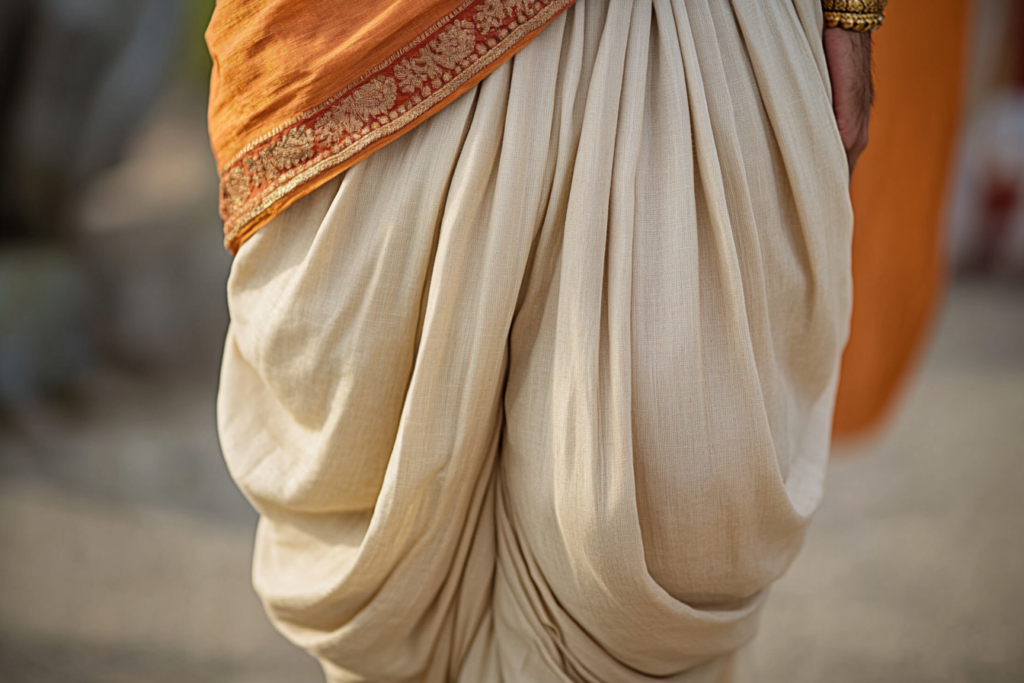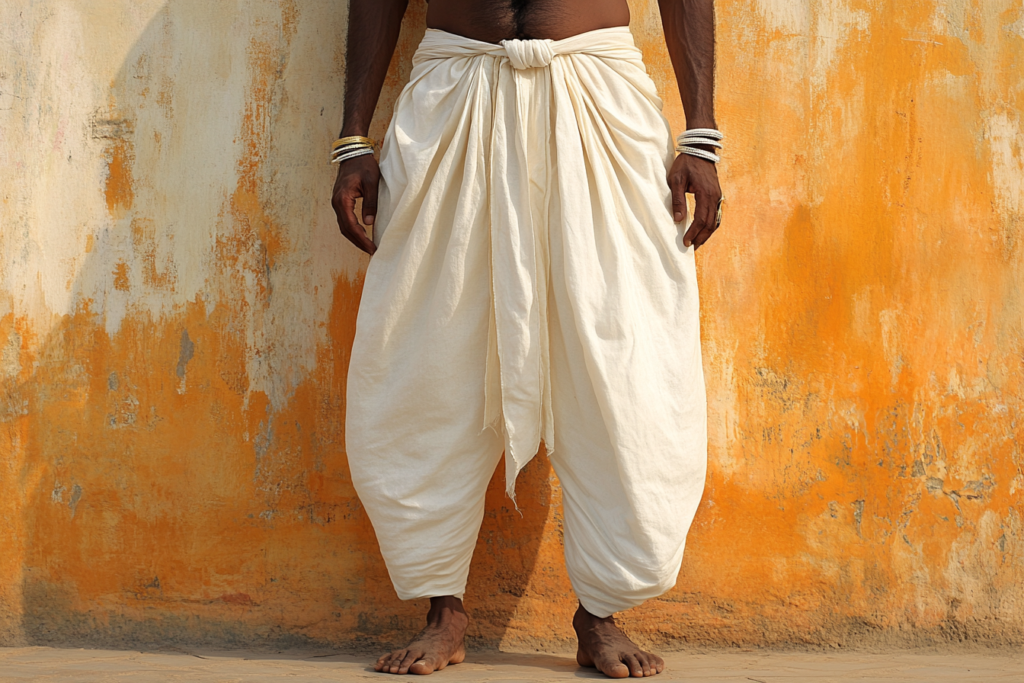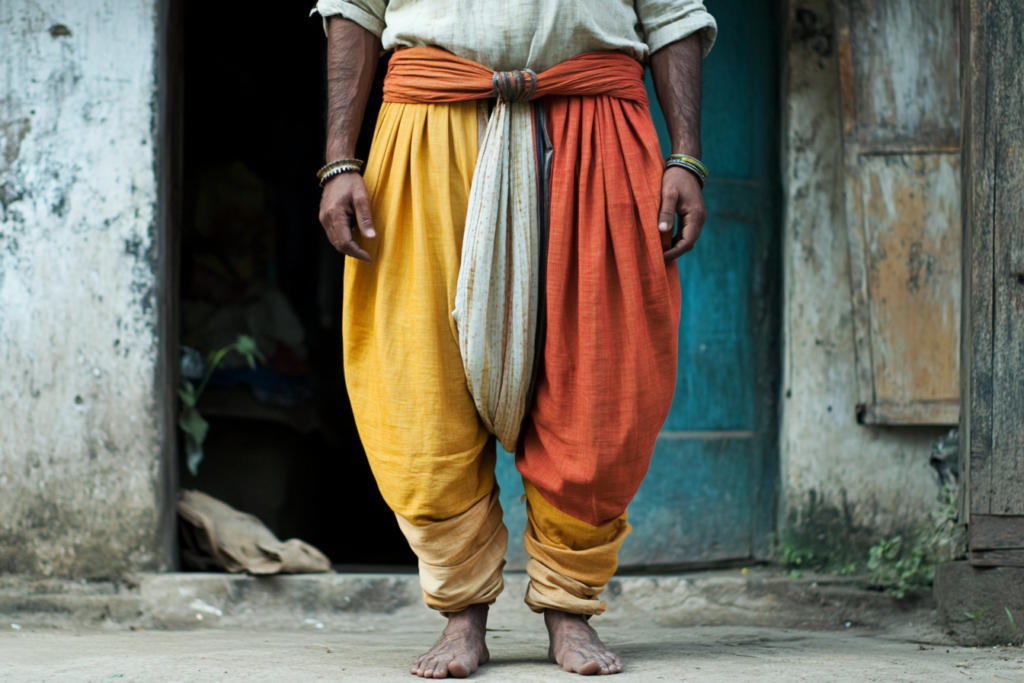Introduction: What is a Dhoti?
The dhoti (pronounced “doe-tee”) is a traditional Indian garment worn primarily by men. It consists of a long strip of cloth, typically made of cotton or silk, that is draped around the waist and legs, with the fabric gathered and secured with a tie or knot at the waist. The dhoti is known for its comfortable fit and versatility, often paired with a kurta or sherwani for formal occasions.
Historically, the dhoti has been worn for centuries and remains a symbol of Indian culture, especially in rural regions and at religious ceremonies. The garment’s design allows for ease of movement and breathability, making it suitable for India’s hot climate. However, in modern fashion, the dhoti has undergone several adaptations, blending tradition with contemporary styles.


The Evolution of the Dhoti
- Historical Significance:
- The dhoti has ancient roots, with its origins tracing back to early Indian civilization. It has been worn by men in India for thousands of years and continues to be a symbol of tradition. Traditionally, the dhoti was crafted from cotton and was tied in various ways depending on the region or occasion.
- The Dhoti in Modern Fashion:
- While the dhoti has remained a mainstay of traditional attire, modern designers have incorporated it into contemporary fashion. For example, the dhoti has evolved into a chic, stylish piece for weddings and formal occasions. Fashion-forward versions of the dhoti feature unique draping styles, patterns, and colors, making it a versatile and fashionable item in both men’s and women’s wardrobes.
- The Dhoti in Pop Culture:
- In recent years, the dhoti has been embraced by Bollywood celebrities and fashion designers, who have used it in modern takes for runway shows and high-profile events. This resurgence of the dhoti in mainstream fashion reflects a broader global interest in traditional ethnic wear and fusion fashion.
How to Wear a Dhoti: A Step-by-Step Guide
- Selecting the Right Fabric:
- The dhoti can be made from a variety of fabrics, ranging from cotton for casual wear to silk or brocade for formal events. The fabric chosen should reflect the occasion and climate. For weddings, formal events, or festivals, a dhoti made from rich, luxurious fabrics like silk can make a bold statement.
- Tying the Dhoti:
- To wear a dhoti, one typically wraps the cloth around the waist, securing it at the front. The fabric is then tucked in to create pleats at the waist. The remaining fabric is folded and draped over the legs, tying it in place with a knot at the waist. Some modern versions may use drawstrings or belts for easy fastening.
- Pairing with a Kurta or Sherwani:
- Traditionally, the dhoti is paired with a kurta or a sherwani, which are long tunics worn on top. The kurta’s relaxed fit and length allow for a perfect pairing with the loose, draped look of the dhoti. For formal occasions, a dhoti might also be paired with a nehru jacket, creating a fusion of traditional and contemporary styles.
The Significance of the Dhoti in Indian Culture
- Cultural Symbolism:
- The dhoti is a symbol of dignity, respect, and cultural heritage. It is worn by men during religious rituals, festivals, and important ceremonies, such as weddings and pujas (Hindu prayer rituals). Its presence in these events reinforces the garment’s role as a marker of tradition and culture.
- Rural and Urban Influence:
- While the dhoti is more common in rural India, it has also made its mark in urban fashion. In villages, the dhoti is worn daily due to its comfort, flexibility, and ease of movement. In cities, the dhoti has transitioned into a symbol of cultural pride, often seen at formal events, weddings, and other occasions.
- The Dhoti and National Identity:
- During the Indian independence movement, leaders like Mahatma Gandhi popularized the dhoti as a symbol of self-reliance and simplicity. Gandhi’s advocacy for the dhoti represented a break from British colonial attire, aligning with the national desire to assert an independent identity.
The Dhoti’s Role in Modern Fashion
- Fusion Wear:
- In modern fashion, the dhoti has been embraced as a part of fusion wear. Designers have innovated by pairing the dhoti with modern garments, such as fitted shirts, jackets, and even western-style blouses. This fusion of Indian and global fashion trends gives the dhoti a fresh, contemporary look while retaining its traditional roots.
- Celebrity Influence:
- Bollywood actors and international celebrities have incorporated the dhoti into their wardrobes, influencing the younger generation’s embrace of the garment. With its elegant draping and distinct style, the dhoti has become a fashionable piece that transcends generations.
- The Dhoti as Wedding Wear:
- In Indian weddings, the dhoti continues to be a favored choice for the groom. Modern brides and grooms alike choose to wear the dhoti paired with a sherwani or traditional wedding attire, creating a timeless and regal look. The trend of wearing a dhoti during weddings has seen a rise in popularity among younger generations who seek a blend of tradition and contemporary flair.
Conclusion: The Timeless Appeal of the Dhoti
The dhoti is much more than just a piece of clothing; it is a representation of Indian tradition, culture, and pride. Whether worn for religious ceremonies, weddings, or in modern fashion statements, the dhoti holds a place in both the history and future of Indian fashion. Its unique design, cultural significance, and versatility make it an enduring garment that continues to be embraced by new generations.
As global interest in sustainable fashion and cultural diversity grows, the dhoti may continue to evolve while staying true to its roots, becoming a symbol of tradition in a modern world.



